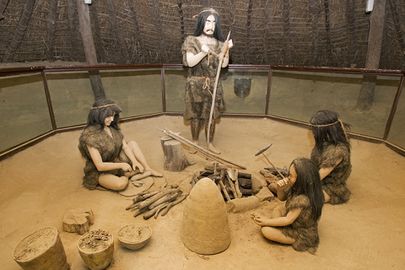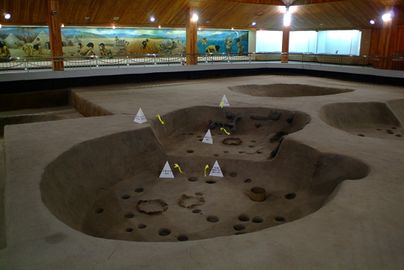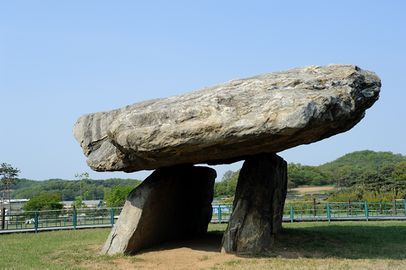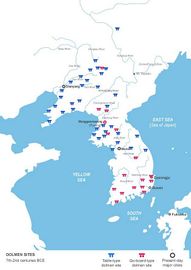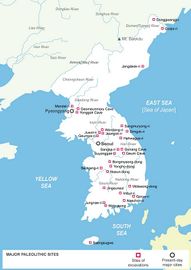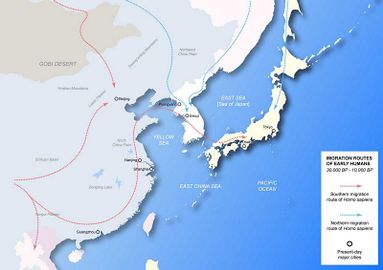"The Dawn of a People - The Prehistory of Korea"의 두 판 사이의 차이
| (같은 사용자의 중간 판 5개는 보이지 않습니다) | |||
| 7번째 줄: | 7번째 줄: | ||
Iron is believed to have begun being produced in the 3rd century BCE. It was widely used for agriculture, weapons, and armor and may have contributed to wood-working tools which gave rise to above-ground wooden houses. Primitive forms of ''ondol'', the native Korean underfloor heating system, were used in advanced pit-houses<ref>The Korean House</ref> during this period. | Iron is believed to have begun being produced in the 3rd century BCE. It was widely used for agriculture, weapons, and armor and may have contributed to wood-working tools which gave rise to above-ground wooden houses. Primitive forms of ''ondol'', the native Korean underfloor heating system, were used in advanced pit-houses<ref>The Korean House</ref> during this period. | ||
| + | |||
<gallery mode=packed heights=180px> | <gallery mode=packed heights=180px> | ||
| − | 파일:1-1.암사동 선사유적 Amsadong Prehistoric Settlement Site (2).jpg| Depiction of the Lives of Prehistoric People at the | + | 파일:1-1.암사동 선사유적 Amsadong Prehistoric Settlement Site (2).jpg| Depiction of the Lives of Prehistoric People who Lived at the Amsadong Prehistoric Settlement Site, Seoul (Courtesy of Korea Tourism Organization, by Kim Ji-ho) |
| − | 파일:1-1.암사동 선사유적 Amsadong Prehistoric Settlement Site.jpg| Reconstructions of | + | 파일:1-1.암사동 선사유적 Amsadong Prehistoric Settlement Site.jpg| Reconstructions of Pithouse Remains from the Amsadong Prehistoric Settlement Site, Seoul (Courtesy of Korea Tourism Organization, by Kim Ji-ho) |
파일:김창락-반구대암각도-1978s.jpg|Documentary Painting of the Korean People [http://dh.aks.ac.kr/Encyves/wiki/index.php/%EA%B9%80%EC%B0%BD%EB%9D%BD-%EC%9A%B8%EC%A3%BC_%EB%B0%98%EA%B5%AC%EB%8C%80_%EC%95%94%EA%B0%81%EB%8F%84 Bangudae Petroglyphs, Ulsan]<br/> (Kim Chang-nak, 1978) | 파일:김창락-반구대암각도-1978s.jpg|Documentary Painting of the Korean People [http://dh.aks.ac.kr/Encyves/wiki/index.php/%EA%B9%80%EC%B0%BD%EB%9D%BD-%EC%9A%B8%EC%A3%BC_%EB%B0%98%EA%B5%AC%EB%8C%80_%EC%95%94%EA%B0%81%EB%8F%84 Bangudae Petroglyphs, Ulsan]<br/> (Kim Chang-nak, 1978) | ||
파일:1-1.고인돌-ESC_8997.jpg|thumb|230px|right|A Dolmen on Ganghwado Island (Bugeun-ri, Hajeom-myeon, Ganghwa-gun, Incheon) | 파일:1-1.고인돌-ESC_8997.jpg|thumb|230px|right|A Dolmen on Ganghwado Island (Bugeun-ri, Hajeom-myeon, Ganghwa-gun, Incheon) | ||
</gallery> | </gallery> | ||
| + | |||
| + | <gallery mode=packed heights=180px> | ||
| + | File:013(E).jpg|Bronze Dagger Sites | ||
| + | File:014(E).jpg|Dolmen Sites | ||
| + | File:015(E).jpg|Major Paleolithic Sites | ||
| + | File:027(E).jpg|Early Human Migration Paths | ||
| + | </gallery> | ||
| + | |||
| + | <youtube description="[The Dolmen, the face of the prehistoric age (K-HERITAGE)]">https://www.youtube.com/watch?v=hK-33nhIXWU</youtube> | ||
=='''Related Articles'''== | =='''Related Articles'''== | ||
| 23번째 줄: | 33번째 줄: | ||
*[[Slender Daggers]] | *[[Slender Daggers]] | ||
*[[Underfloor Heating (Ondol)]] | *[[Underfloor Heating (Ondol)]] | ||
| + | |||
| + | =='''References'''== | ||
| + | <references/> | ||
| + | |||
| + | [[Category:An Overview of Korean History]] | ||
2017년 11월 29일 (수) 15:22 기준 최신판
Humans occupied the Korean peninsula from as early as 500,000 years ago. Paleolithic archaeological sites, with human bones and artifacts, give some clues as to the type of early stone tools and their development over time, while sites from the neolithic period (dating from 6,000 BCE) contain pottery, chipped and ground stone tools, and consist of semi-subterranean houses grouped into small villages[1]. Sites on the east coast contained pottery with raised designs, while slightly later sites on the west coast contained comb-pattern pottery. These pottery styles spread prolifically across the peninsula from approximately 8,000-1,500 BCE. This period was a time of hunting, fishing, and small-scale plant cultivation.
The emergence of undecorated pottery is considered a marker for the next developmental period, which lasted from approximately 1,500 - 300 BCE. It was during this period that agriculture, rice cultivation in particular, developed. Settlements moved from riverbanks to hillsides to make better use of the flat land by the rivers for farming. Burial practices during this period became more advanced, with megalithic dolmens used as tombs for tribal chiefs. Korean dolmens make up over 70 percent of the world's dolmens and some have been registered as UNESCO World Heritages. Use of bronze began during this period, appearing in the form of slender daggers found only on the Korean peninsula and mandolin-shaped daggers which made their way from northwest China all the way to southwest Korea, indicative of widespread trade. However, bronze items were uncommon and reserved for the elite, usually utilized for weapons and ornaments.
Iron is believed to have begun being produced in the 3rd century BCE. It was widely used for agriculture, weapons, and armor and may have contributed to wood-working tools which gave rise to above-ground wooden houses. Primitive forms of ondol, the native Korean underfloor heating system, were used in advanced pit-houses[2] during this period.
Documentary Painting of the Korean People Bangudae Petroglyphs, Ulsan
(Kim Chang-nak, 1978)
Related Articles
- Raised-pattern Pottern
- Comb-pattern Pottery
- Undecorated Pottery
- Dolmens
- Mandolin-shaped Daggers
- Slender Daggers
- Underfloor Heating (Ondol)
